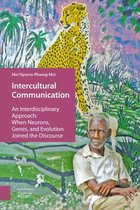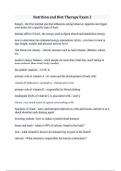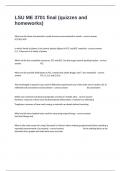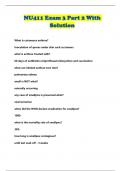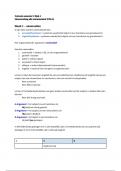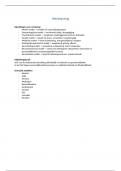CCA Complete Summary of the Whole Book
Chapter 1 The Survival of the Most Cultured
1.1 The Nature of Culture
In animals, genes evolve to guide their behaviors and their survival. In human beings, genes
have been largely replaced by culture. Culture evolves and guides our behaviors and teaches
us how to survive.
Culture is initially formed by the ability to imitate, to select the best practices, and to
transfer them to others. Instead of waiting for a change in genes so humans can evolve
wings to fly (which may never happen), culture allows us to pull ideas together and build
airplanes.
1.2 Cultural Diversity
Cultural diversity can be explained by:
The impact of environment, with theories ranging from a deciding factor
(determinism), an influential factor (probabilism), a source of possibilities
(possibilism), to an entity inseparable from the human species (ecology).
The role of linguistic and cultural diversity, which are regulators for (1) safeguarding
cultural resources, recognizing who we can trust; and (2) negotiating cultural
resources with other human groups for mutual interest.
1.3 Diversity Pathways
The selection of genes depends on the coevolution with culture: a specific cultural value may
prefer a certain gene, and a certain gene may slowly reinforce a certain cultural value.
Neurons that fire together, wire together. Our thoughts change our brain physically. The
brain’s plasticity means that we are capable of adapting to new environments and
representing multiple cultures in our mind, depending on the context.
Our potential is not completely hard-wired in DNA. Genes are not totally fixed from birth,
and can be modified by behaviors.
Behaviors are not the end point of interaction. They are both the consequence and the
driving force of culture and environment. At the same time, behaviors are directed by genes,
but can also modify genes.
1.4 Globalization
Despite the immense diversity, humans are the only species who can extend cooperation
beyond kinship and form larger communities of unrelated individuals, thanks to the capacity
of culture. This insight questions the mainstream economic model of “homo economicus” –
the notion that humans are rational, selfish, and will attempt to maximize their utility for
gains.
, Globalization is not new, but in the modern era, this process is driven by different
factors: (a) speed of technology and information development; (b) rapid changes in
global demography; and (c) the emergence of a global economy.
By being exposed to different cultures and purposely changing our behaviors, our
brains can become culturally tuned, allowing us to adapt to any culture on demand.
Summary Chapter 1 – The Survival of the Most Cultured
1. It is mostly our culture, not or genes that supplies the majority of solutions and guidance
we use to survive and prosper in the society of our birth. Hence, culture is the survival
strategy of our species. Instead of waiting for genes to evolve, we use ideas (culture) to
advance.
2. The capacity for culture began with social learning, or the ability to learn and imitate
others, to select the best practices, improve them, and teach them to others.
3. Cultural diversity is crucial because it is a regulator for (a) safeguarding cultural resources,
recognizing who we can trust; and (b) negotiating cultural resources with other human
groups for mutual interests. Effective resource management can lead to both dividing and
merging of cultures.
4. The diversity in human’s many cultures is driven by many factors that dynamically interact
with one another: environment, genes, brain and behavior. None of them is static. Each one
is simultaneously a driving force and impacted by the others (plasticity)
The impact of environment on cultural diversity is influential, with theories ranging
from a deciding factor (determinism), an influential factor (probabilism), a source of
possibilities (possibilism), to an entity that is inseparable from the human species
(ecology). According to the Diagram of Diversity Pathways, environment can take a
dynamic role, both influencing and being subjected to the impact of cultural and
human behaviors, depending on a particular context.
Genes carry the codes of human development and behavior. However, genes are not
totally fixed from birth and can be modified by behaviors. The selection of genes also
depends on the coevolution with culture: a specific cultural value may prefer a
certain gene, and a certain gene may slowly create a certain cultural value.
The brain is a dynamic device that can grow, develop and rewire itself in response to
new behaviors and adapt to a culture on demand. The brain’s plasticity means that
traits are unlikely to be “hard-wired” from birth, rather they are the consequence of
repeated behaviors.
Behaviors are both the consequence and the driving force of culture and
environment. At the same time, behaviors are directed by genes and brains, but can
also modify genes and the brain.
, 5. Despite the immense diversity, thanks to the capacity of culture, humans are the only
species that can extend cooperation beyond kinship and form larger communities of
unrelated individuals. This insight questions the mainstream economic model of “homo
economicus” – the notion that humans are rational, selfish, and will attempt to maximize
their utility for gains.
6. Globalization is not new, but in the modern era, this process is driven by different factors:
(a) the speed of technology and information development; (b) rapid changes in global
demography; and (c) the emergence of a global economy.
Chapter 2 – The Evolving Culture
2.1 The metaphorical tree of culture
The “tree of culture” has tree components:
Fundamental concerns: For example, hierarchy
Values: For example, “low”, “average”, or “high” degree of importance placed on
hierarchy.
Outward expressions: For example, respectful behaviors towards authority, seeking
instruction from seniority, practicing inequality between subordinates and superiors,
using honorific titles, etc.
2.2 The change in culture
Context is the main indicator for predicting change within and between cultures. Paradoxes
and contrasting values/outward expressions xo-exist, manifesting themselves depending on
particular contexts.
Context aside, fundamental concerns are pretty stable, values (i.e. the degree of importance)
are dynamic, but outward expressions change the fastest of all.
Outward expressions can be misleading as they do not always match values. A change of
outward expressions does not readily reflect a genuine change of values, and vice versa.
2.3 The inverted pyramid model
The starting point for fruitful intercultural exchanges should be built upon similarities at the
universal level. This creates a foundation of trust, acting as a positive springboard that helps
us to see diversity and differences in a positive light.
Chapter 1 The Survival of the Most Cultured
1.1 The Nature of Culture
In animals, genes evolve to guide their behaviors and their survival. In human beings, genes
have been largely replaced by culture. Culture evolves and guides our behaviors and teaches
us how to survive.
Culture is initially formed by the ability to imitate, to select the best practices, and to
transfer them to others. Instead of waiting for a change in genes so humans can evolve
wings to fly (which may never happen), culture allows us to pull ideas together and build
airplanes.
1.2 Cultural Diversity
Cultural diversity can be explained by:
The impact of environment, with theories ranging from a deciding factor
(determinism), an influential factor (probabilism), a source of possibilities
(possibilism), to an entity inseparable from the human species (ecology).
The role of linguistic and cultural diversity, which are regulators for (1) safeguarding
cultural resources, recognizing who we can trust; and (2) negotiating cultural
resources with other human groups for mutual interest.
1.3 Diversity Pathways
The selection of genes depends on the coevolution with culture: a specific cultural value may
prefer a certain gene, and a certain gene may slowly reinforce a certain cultural value.
Neurons that fire together, wire together. Our thoughts change our brain physically. The
brain’s plasticity means that we are capable of adapting to new environments and
representing multiple cultures in our mind, depending on the context.
Our potential is not completely hard-wired in DNA. Genes are not totally fixed from birth,
and can be modified by behaviors.
Behaviors are not the end point of interaction. They are both the consequence and the
driving force of culture and environment. At the same time, behaviors are directed by genes,
but can also modify genes.
1.4 Globalization
Despite the immense diversity, humans are the only species who can extend cooperation
beyond kinship and form larger communities of unrelated individuals, thanks to the capacity
of culture. This insight questions the mainstream economic model of “homo economicus” –
the notion that humans are rational, selfish, and will attempt to maximize their utility for
gains.
, Globalization is not new, but in the modern era, this process is driven by different
factors: (a) speed of technology and information development; (b) rapid changes in
global demography; and (c) the emergence of a global economy.
By being exposed to different cultures and purposely changing our behaviors, our
brains can become culturally tuned, allowing us to adapt to any culture on demand.
Summary Chapter 1 – The Survival of the Most Cultured
1. It is mostly our culture, not or genes that supplies the majority of solutions and guidance
we use to survive and prosper in the society of our birth. Hence, culture is the survival
strategy of our species. Instead of waiting for genes to evolve, we use ideas (culture) to
advance.
2. The capacity for culture began with social learning, or the ability to learn and imitate
others, to select the best practices, improve them, and teach them to others.
3. Cultural diversity is crucial because it is a regulator for (a) safeguarding cultural resources,
recognizing who we can trust; and (b) negotiating cultural resources with other human
groups for mutual interests. Effective resource management can lead to both dividing and
merging of cultures.
4. The diversity in human’s many cultures is driven by many factors that dynamically interact
with one another: environment, genes, brain and behavior. None of them is static. Each one
is simultaneously a driving force and impacted by the others (plasticity)
The impact of environment on cultural diversity is influential, with theories ranging
from a deciding factor (determinism), an influential factor (probabilism), a source of
possibilities (possibilism), to an entity that is inseparable from the human species
(ecology). According to the Diagram of Diversity Pathways, environment can take a
dynamic role, both influencing and being subjected to the impact of cultural and
human behaviors, depending on a particular context.
Genes carry the codes of human development and behavior. However, genes are not
totally fixed from birth and can be modified by behaviors. The selection of genes also
depends on the coevolution with culture: a specific cultural value may prefer a
certain gene, and a certain gene may slowly create a certain cultural value.
The brain is a dynamic device that can grow, develop and rewire itself in response to
new behaviors and adapt to a culture on demand. The brain’s plasticity means that
traits are unlikely to be “hard-wired” from birth, rather they are the consequence of
repeated behaviors.
Behaviors are both the consequence and the driving force of culture and
environment. At the same time, behaviors are directed by genes and brains, but can
also modify genes and the brain.
, 5. Despite the immense diversity, thanks to the capacity of culture, humans are the only
species that can extend cooperation beyond kinship and form larger communities of
unrelated individuals. This insight questions the mainstream economic model of “homo
economicus” – the notion that humans are rational, selfish, and will attempt to maximize
their utility for gains.
6. Globalization is not new, but in the modern era, this process is driven by different factors:
(a) the speed of technology and information development; (b) rapid changes in global
demography; and (c) the emergence of a global economy.
Chapter 2 – The Evolving Culture
2.1 The metaphorical tree of culture
The “tree of culture” has tree components:
Fundamental concerns: For example, hierarchy
Values: For example, “low”, “average”, or “high” degree of importance placed on
hierarchy.
Outward expressions: For example, respectful behaviors towards authority, seeking
instruction from seniority, practicing inequality between subordinates and superiors,
using honorific titles, etc.
2.2 The change in culture
Context is the main indicator for predicting change within and between cultures. Paradoxes
and contrasting values/outward expressions xo-exist, manifesting themselves depending on
particular contexts.
Context aside, fundamental concerns are pretty stable, values (i.e. the degree of importance)
are dynamic, but outward expressions change the fastest of all.
Outward expressions can be misleading as they do not always match values. A change of
outward expressions does not readily reflect a genuine change of values, and vice versa.
2.3 The inverted pyramid model
The starting point for fruitful intercultural exchanges should be built upon similarities at the
universal level. This creates a foundation of trust, acting as a positive springboard that helps
us to see diversity and differences in a positive light.

